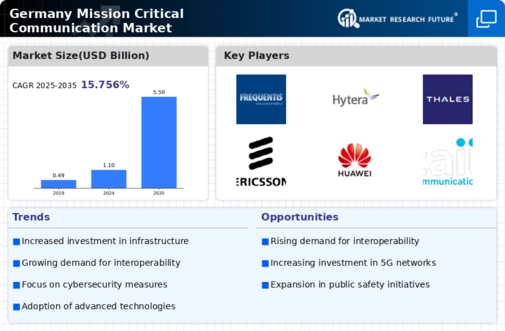The mission critical-communication market in Germany is characterized by a dynamic competitive landscape, driven by technological advancements and increasing demand for reliable communication systems across various sectors, including public safety, transportation, and utilities. Key players such as Motorola Solutions (US), Thales Group (FR), and Siemens (DE) are strategically positioned to leverage innovation and partnerships to enhance their offerings. Motorola Solutions (US) focuses on integrating advanced analytics and AI into its communication solutions, while Thales Group (FR) emphasizes cybersecurity and interoperability in its systems. Siemens (DE) is actively pursuing digital transformation initiatives, aiming to optimize operational efficiency and enhance user experience, thereby collectively shaping a competitive environment that prioritizes technological sophistication and reliability.
In terms of business tactics, companies are increasingly localizing manufacturing and optimizing supply chains to enhance responsiveness to market demands. The market structure appears moderately fragmented, with several key players exerting influence through strategic collaborations and technological advancements. This fragmentation allows for a diverse range of solutions, catering to the specific needs of various sectors, while also fostering competition that drives innovation.
In October 2025, Thales Group (France) announced a partnership with a leading German telecommunications provider to develop next-generation secure communication networks. This collaboration is poised to enhance the resilience and security of critical communication infrastructures, reflecting Thales's commitment to addressing emerging cybersecurity threats. The strategic importance of this partnership lies in its potential to set new standards for secure communications in Germany, aligning with the increasing regulatory focus on data protection and privacy.
In September 2025, Siemens (Germany) unveiled a new suite of digital communication tools designed for emergency services, integrating real-time data analytics and AI capabilities. This launch signifies Siemens's strategic pivot towards enhancing operational efficiency in mission-critical scenarios. By leveraging AI, Siemens aims to provide emergency responders with actionable insights, thereby improving response times and overall effectiveness in crisis situations. This move not only strengthens Siemens's market position but also underscores the growing trend of integrating AI into mission-critical communication systems.
In November 2025, Motorola Solutions (US) expanded its presence in Germany by acquiring a local software firm specializing in emergency response solutions. This acquisition is likely to enhance Motorola's capabilities in delivering tailored solutions for public safety agencies, reflecting a broader trend of consolidation in the market. By integrating local expertise, Motorola aims to strengthen its competitive edge and better serve the unique needs of German customers, indicating a shift towards localized solutions in mission-critical communications.
As of November 2025, current competitive trends in the mission critical-communication market are increasingly defined by digitalization, sustainability, and AI integration. Strategic alliances are becoming pivotal in shaping the landscape, as companies seek to combine strengths to address complex challenges. The competitive differentiation is likely to evolve from traditional price-based competition towards a focus on innovation, technology, and supply chain reliability. This shift suggests that companies that prioritize technological advancements and collaborative strategies will be better positioned to thrive in an increasingly complex market.






















Leave a Comment